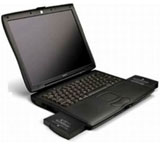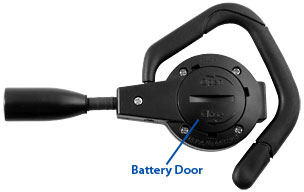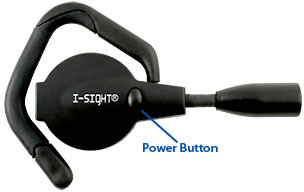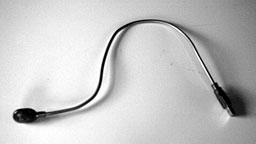One thing about living in Atlantic Canada - the weather is rarely
dull. Bob Hope once quipped on a visit to Nova Scotia that it was the
only place he'd ever been that he experienced all four seasons in one
day, and it's been said, "If you don't like the weather, wait an hour
or two." Not far off the mark.
In the past week here in Nova Scotia, we've had temperatures in the
high 60s and in the teens, Fahrenheit. And while we had our first major
winter storm over a month ago, winter officially arrived on Sunday with
a major blizzard packing hurricane-force gusts and knocking out power
for some 100,000 homes, which translates to about one-quarter to
one-third of the province's population in the dark.
Here on the eastern mainland coast, we got off relatively lightly,
so to speak. The wind last night howled like an enraged wild animal,
and it went on and on and on, but we didn't get a whole lot of snow,
and the power at my house managed to hang in through the worst of the
storm with a few flickers and momentary cutouts. It finally succumbed
around noon on Monday.
3 Cheers for Notebooks!
This once more gave me occasion to thank myself for using laptop
computers. The power came back on here after about nine hours, although
the wait for restoration for some is estimated for late Tuesday
evening, which is a long time to go without power in December with
temperatures well below freezing.
 I just
transferred my current work-in-progress and email files to one of my
Pismo PowerBooks, which
share three FastMac and Newer Technology extended life batteries, each
of which can squeeze more than five hours out of a full battery charge.
I was working on one of the Pismos when the power went off and didn't
even notice until I hit a light switch.
I just
transferred my current work-in-progress and email files to one of my
Pismo PowerBooks, which
share three FastMac and Newer Technology extended life batteries, each
of which can squeeze more than five hours out of a full battery charge.
I was working on one of the Pismos when the power went off and didn't
even notice until I hit a light switch.
The laptop just quietly shifts to running on battery power without a
hiccup. Indeed, it would be more convenient if a little alarm chime or
some such would sound when the power shift happens. I used up about 15%
of a battery charge before I realized it and turned the screen
brightness down a few notches.
We're reasonably well fixed for such exigencies on this property. We
heat primarily with wood, and both of our stoves are
electricity-independent. We also have gravity-fed water from an
artesian spring, so we can wash, the toilets keep flushing, and we're
warm and able to cook food and heat water on the wood stove. And as
long as the phone lines aren't affected by an outage, we can still get
on the Internet, which is one reason among many that I would no longer
seriously consider a desktop computer of any sort as a workhorse
machine.
When the power cuts out, the portables instantly shift to battery
power, preserving any unsaved work and allowing you to finish up
whatever you were doing gracefully. The same kind of security and
ability to carry on computing with a desktop machine would require a
really big (and expensive) uninterruptible power supply (UPS) unit,
which also would add another layer of complication and clutter - and
cancel out the price advantage of using a desktop machine.
Charging Batteries During a Blackout
On the other hand, you can keep a laptop computer going for a couple
of days on its internal battery if you ration your use, especially if
you have one of the new, extended life replacement batteries that are
available. With a laptop, a cheap power inverter, and a car battery,
you should be able to ride out even a lengthy power interruptions if
you have a means of periodically recharging the battery - I can
recharge my batteries if I need more than 15 hours or so.
After a major November storm a few years back, I bought a 700 amp
rechargeable power pack, which has an automobile cigarette-lighter type
socket into which will 12 volt items, such as my Kensington 70 watt
Auto Air power adapter (unfortunately now discontinued) can be plugged.
I also have a little 300 amp power inverter that converts 12 volts DC
(i.e.: a car battery) into 120 volts AC, but I prefer to use the
Kensington device, because the inverter itself draws a fair bit of
charge. Running a laptop computer with this setup involves stepping 12
volts DC up to 110 volts AC, and then back down to 24 volts DC with the
laptop's AC adapter - not a very efficient process.
Another deficiency of the power pack is that its little 1.5 amp
internal trickle charger takes about 36 hours to charge the pack if
it's fully depleted. You can charge it faster by hooking at up to a
higher amperage charger or to a running automobile, but the manual says
that will shorten its life if done often.
A Little Light
 Something I've found extremely useful during power
blackouts is RadTech's I-Sight
ear-worn personal illuminator. The I-Sight's overdriven, super-bright
Nichea LED module features a parabolic reflector and precision focusing
lens to provide an amazingly bright and uniform beam pattern, with no
hotspots - just pure and even lighting. The manufacturer claims up to
one mile visibility - and it certainly is very bright. I-Sight's
reversible and adjustable ear loop allows use with or without glasses
on left or right ears.
Something I've found extremely useful during power
blackouts is RadTech's I-Sight
ear-worn personal illuminator. The I-Sight's overdriven, super-bright
Nichea LED module features a parabolic reflector and precision focusing
lens to provide an amazingly bright and uniform beam pattern, with no
hotspots - just pure and even lighting. The manufacturer claims up to
one mile visibility - and it certainly is very bright. I-Sight's
reversible and adjustable ear loop allows use with or without glasses
on left or right ears.
The I-Sight provides a keyboard lighting solution if you have no
other general light source, but it really comes into its own when you
need to wander through the house, or even outdoors, looking for things
or just getting on with the necessities of life.
 Weighing just 18 grams and featuring a claimed useable,
continuous runtime of over 36 hours, I-Sight illuminates the wearer's
field of vision with no distracting side flare while keeping both hands
free. An easy-to-use push-button power switch, aimable lamp module on a
flexible stalk, and tool-less battery replacement round out the feature
array.
Weighing just 18 grams and featuring a claimed useable,
continuous runtime of over 36 hours, I-Sight illuminates the wearer's
field of vision with no distracting side flare while keeping both hands
free. An easy-to-use push-button power switch, aimable lamp module on a
flexible stalk, and tool-less battery replacement round out the feature
array.
The I-Sight illuminates whatever you look at, not just a portion of
the keyboard. This may be a positive or negative characteristic,
depending on your needs and circumstances. If you want a keyboard
illuminator in order to avoid disturbing someone trying to sleep or
watching TV in low light in the same room, you may find the I-Sight
too bright. Some flashlights are a lot dimmer. The I-Sight's
beam is quite focused, but there is some scatter from the glow. On the
other hand, if you just need to light up your work space, it does a
fine job. You won't have any trouble seeing the keys.
However, USB powered keyboard lights have an edge here, never
needing battery replacement. On the other hand, the USB lights eat up
precious battery charge. Replacement batteries for the I-Sight cost
about six to eight dollars.
The I-Sight is default configured to be worn on the right ear, but
it can be quickly converted for left ear use, and is it compatible with
eyeglasses and Bluetooth headsets. It works fine with my wire rimmed
specs.
I-Sight sells for $12.95.
 Speaking of USB-powered keyboard lights, I
also have a LapWorks USB Nite Key
Lite - an 18" long serpentine keyboard lamp with two white LEDs
that does a fine job of lighting the keyboard for non-touch typists
like me, albeit at the aforementioned charge life penalty.
Speaking of USB-powered keyboard lights, I
also have a LapWorks USB Nite Key
Lite - an 18" long serpentine keyboard lamp with two white LEDs
that does a fine job of lighting the keyboard for non-touch typists
like me, albeit at the aforementioned charge life penalty.
 The Nite Key Lite plugs into and draws power
from one of your 'Book's USB ports - but not necessarily a whole lot of
power. LapWorks says that the Nite Key Lite's power consumption amounts
to roughly 90 seconds per hour of battery life on average. The bulbless
LED units have a projected service life of up to 8,000 hours. It comes
with a lifetime warranty and sells for $14.95.
The Nite Key Lite plugs into and draws power
from one of your 'Book's USB ports - but not necessarily a whole lot of
power. LapWorks says that the Nite Key Lite's power consumption amounts
to roughly 90 seconds per hour of battery life on average. The bulbless
LED units have a projected service life of up to 8,000 hours. It comes
with a lifetime warranty and sells for $14.95.
Purchase Links

 I just
transferred my current work-in-progress and email files to one of my
I just
transferred my current work-in-progress and email files to one of my
 Something I've found extremely useful during power
blackouts is
Something I've found extremely useful during power
blackouts is  Weighing just 18 grams and featuring a claimed useable,
continuous runtime of over 36 hours, I-Sight illuminates the wearer's
field of vision with no distracting side flare while keeping both hands
free. An easy-to-use push-button power switch, aimable lamp module on a
flexible stalk, and tool-less battery replacement round out the feature
array.
Weighing just 18 grams and featuring a claimed useable,
continuous runtime of over 36 hours, I-Sight illuminates the wearer's
field of vision with no distracting side flare while keeping both hands
free. An easy-to-use push-button power switch, aimable lamp module on a
flexible stalk, and tool-less battery replacement round out the feature
array. Speaking of USB-powered keyboard lights, I
also have a
Speaking of USB-powered keyboard lights, I
also have a  The Nite Key Lite plugs into and draws power
from one of your 'Book's USB ports - but not necessarily a whole lot of
power. LapWorks says that the Nite Key Lite's power consumption amounts
to roughly 90 seconds per hour of battery life on average. The bulbless
LED units have a projected service life of up to 8,000 hours. It comes
with a lifetime warranty and sells for $14.95.
The Nite Key Lite plugs into and draws power
from one of your 'Book's USB ports - but not necessarily a whole lot of
power. LapWorks says that the Nite Key Lite's power consumption amounts
to roughly 90 seconds per hour of battery life on average. The bulbless
LED units have a projected service life of up to 8,000 hours. It comes
with a lifetime warranty and sells for $14.95.
